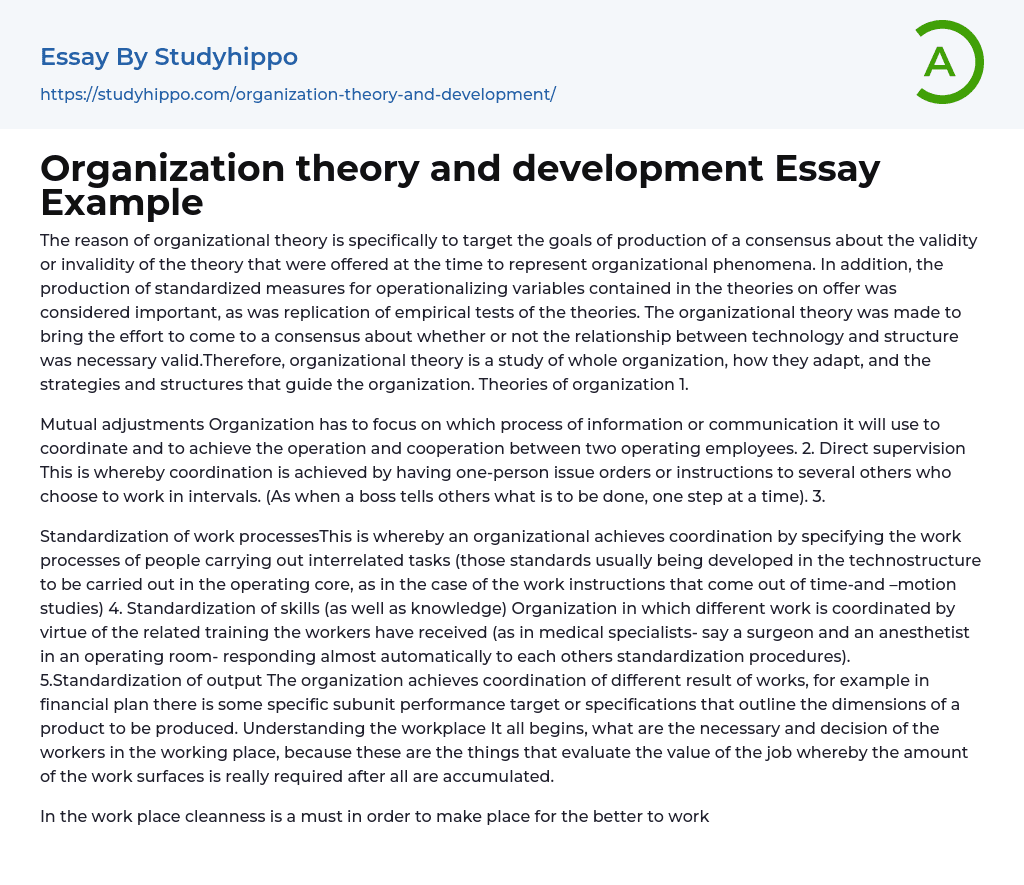The purpose of organizational theory is to achieve a consensus regarding the validity or invalidity of theories proposed to represent organizational phenomena, and to generate standardized measures for operationalizing variables contained in these theories. Empirical tests of these theories are also important for replication. The main aim of organizational theory is to establish whether the relationship between technology and structure is valid. Therefore, organizational theory studies the entire organization, including how it adapts and the strategies and structures it employs.
In order to coordinate and facilitate operational and cooperative efforts between two employees, an organization must prioritize its information and communication processes. This coordination can take the form of direct supervision, where one individual issues instructions to several others who work in intervals. This type of supervision involves a boss providing step-by-step guidance for what needs to
...be accomplished.
Standardization of work processes, skills, and output is crucial for achieving coordination within an organization. Work processes are specified in order to coordinate the interrelated tasks of workers, often developed by the technostructure and carried out in the operating core. Standardization of skills and knowledge allows for workers with different specialties to coordinate their efforts effectively, such as a surgeon and an anesthetist in an operating room. Finally, standardization of output ensures that different work results are coordinated, often through performance targets or product specifications. Ultimately, an understanding of the necessary decisions and actions of workers in the workplace is key to evaluating job value and determining required workloads.
Maintaining cleanliness in the workplace is essential for creating a conducive and organized work environment. When the workplace is well-organized, it prompts workers to stay committed an
dedicated to sustaining the system. The result of this effort is improved efficiency, quality, decreased accidents, and more time for value-added work. To achieve this desirable outcome, remember to sort, shine, set in order standardized and sustain - these are the five principles that guarantee a supportive and safe work climate. Furthermore, prioritizing psychological well-being in the workplace will have a positive impact on workers' health, organizational behavior, and productivity. By creating good working conditions, there will be improved dynamic and employee interaction, which ultimately leads to increased productivity.
(Levy, 2003) states that Industrial Organizational Psychology is necessary for comprehending the work environment. Reference: Levy, P. E. (2003). Industrial organization psychology: understanding the workplace.
Houghton Mifflin is the content within an HTML paragraph tag.
- Anatomy and Physiology essays
- Addiction essays
- Biodegradation essays
- Dental Care essays
- Disease essays
- Disorders essays
- Health Care essays
- Intelligence Quotient essays
- Nutrition essays
- Olfaction essays
- Public Health essays
- Women's Health essays
- World health organization essays
- Cancer essays
- Infectious Disease essays
- Lung Cancer essays
- Neurology essays
- Physical Exercise essays
- Medicine essays
- Sex essays
- Inquiry essays
- Disability essays
- Poison essays
- Action Potential essays
- Nervous System essays
- Childbirth essays
- Puberty essays
- Blood essays
- Kidney essays
- Neuron essays
- Body essays
- Glucose essays
- Sense essays
- Heart essays
- Skeleton essays
- Human Physiology essays
- Eye essays
- Immune System essays
- Muscle essays
- Skin essays
- Brain essays
- Central Nervous System essays
- Human Skin Color essays
- Digestive System essays
- Common sense essays
- Respiration essays
- alcoholism essays
- Smoking essays
- Casino essays
- Tobacco essays




